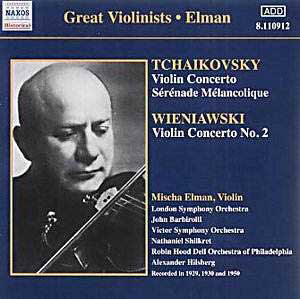Naxos continue their invaluable series of budget price
historical issues with this release celebrating Mischa Elman (1891-1967).
Born near Kiev, Elman began to play the violin at the age of four. Seven
years later his talent was such that he was accepted as a pupil by the
great Leopold Auer in St. Petersburg (it’s Auer’s edition of the Tchaikovsky
concerto which is recorded here.) However, Elman’s formal training only
lasted until he was fourteen. After 1911 he was based in the USA. Tully
Potter, the author of the accompanying notes comments that, after early
celebrity, by the 1920s Elman’s star was eclipsed by the even brighter
star of Heifetz.
Potter credits Elman as the man who "initiated
and inspired the wave of superb Jewish violinists who poured out of
the East European ghettos in the first quarter of [the twentieth] century."
On the evidence of these recordings he certainly lacked Heifetz’s steely
virtuosity and panache. On the other hand, he possessed a warm, generous
tone and, as Potter observes, it seems that he was more effective in
slower music than in passages of "fireworks".
This performance of the Tchaikovsky concerto is one
of the most mellow, reflective even, that I can recall hearing. For
example, the passage following the first movement cadenza (track 1 from
12’22") is played with an unusual degree of seamless legato; I
can imagine many listeners will find the playing here too smooth.
The first movement as a whole is almost gentle in Elman’s hands; it
is certainly poetic but after a while I began to crave more urgency
and fire in the playing.
The wistful melancholy of the slow movement suits Elman’s
style better. Indeed, this is a rather affecting account of the music.
The finale has something of the bite that was missing in the first movement
- though it could take more. The accompaniment from Barbirolli and the
LSO, though rather backwardly recorded, seems deft and attentive. It
was work such as this which brought Barbirolli to the notice of several
great soloists and helped to lead him a few years later to the podium
of the New York Philharmonic Symphony Orchestra. Though the balance
favours the soloist at the expense of the orchestra (as was usual in
those days) the sound is perfectly acceptable and Mark Obert-Thorn’s
transfer is a good one.
The source material for the other Tchaikovsky item
was clearly less satisfactory for there is quite a bit more surface
hiss apparent. Elman’s performance of the Sérénade
Mélancolique is similar to his account of the concerto’s
slow movement. He is at home with the songful nostalgia of such a piece
and plays it with affection and feeling. It may be a fairly slight work
but Elman invests it with just the right degree of pathos, without over-indulgence.
The sound of his violin reproduces quite well but the orchestra sounds
confined. To my ears the HMV engineers, working in the Queens Hall achieved
much better results than did their American colleagues a few months
later
The Wieniawski concerto was recorded much later in
Elman’s career and, naturally, it gets better sound. The orchestra,
of course, is the Philadelphia Orchestra, playing for contractual reasons
under a none-too-subtle alias. Here they are conducted by their then-Concertmaster
and Assistant Conductor, Alexander Hilsberg, who was himself a pupil
of Auer. The recording was made in a pretty reverberant acoustic but
still sounds well. I was intrigued by the rather east European sound
of the first horn (sample his short solo on track 5 at 0’17").
At this time American orchestras very often showed the influence of
European Jewish émigrés in their string sections but it
is much less usual, I think, to find such evidence among wind and brass
players. Hilsberg and the orchestra support Elman well.
I must admit that the work itself is not one which
appeals to me very much. The music seems to be pretty feeble. However,
Elman projects the solo part strongly and with conviction. Once again,
he appears to best advantage in the slower, lyrical passages and the
second movement, a Romance, strikes me as the most successful.
This is something of a mixed disc. The interpretation
of the Tchaikovsky concerto is idiosyncratic. As such, it will not appeal
to all but it is an interesting alternative view and it is certainly
a sincere account of the work. It would not be a first choice but it
should not be overlooked. If the Wieniawski is to your taste, you will
want to investigate this performance. These are truly performances from
another age and will be of great interest to violin aficionados though
their appeal to non-specialist listeners may be more limited, even at
the Naxos price.
John Quinn


